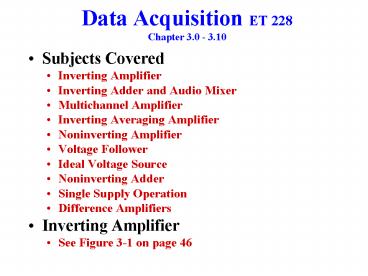Data Acquisition ET 228 Chapter 3.0 - 3.10 - PowerPoint PPT Presentation
1 / 10
Title:
Data Acquisition ET 228 Chapter 3.0 - 3.10
Description:
Data Acquisition ET 228Chapter 3.0 - 3.10. Inverting Amplifier. Simplifying Assumptions. E d is essentially 0 if V out is not in saturation. Input terminal currents ... – PowerPoint PPT presentation
Number of Views:90
Avg rating:3.0/5.0
Title: Data Acquisition ET 228 Chapter 3.0 - 3.10
1
Data Acquisition ET 228Chapter 3.0 - 3.10
- Subjects Covered
- Inverting Amplifier
- Inverting Adder and Audio Mixer
- Multichannel Amplifier
- Inverting Averaging Amplifier
- Noninverting Amplifier
- Voltage Follower
- Ideal Voltage Source
- Noninverting Adder
- Single Supply Operation
- Difference Amplifiers
- Inverting Amplifier
- See Figure 3-1 on page 46
2
Data Acquisition ET 228Chapter 3.0 - 3.10
- Inverting Amplifier
- Simplifying Assumptions
- Ed is essentially 0 if Vout is not in saturation
- Input terminal currents in negligible
- Formulas for Figures 3-1, 3-2, 3-3
- On Pages 46, 48, and 50
- I Ei/Ri
- I determined by the input voltage and input
resistor - Voltage drop across the feedback resistor
- Vrf I x Rf Ei/Ri Rf
- Output voltage - Across the load
- VOut - EiRf / Ri
- Output Current
- IOut I IL
3
Data Acquisition ET 228Chapter 3.0 - 3.10
- Inverting Amplifier
- Example Problems
- Examples 3-1 and 3-2 on page 47
- Example 3-3 on page 49
- Walk through applying Ei per Figure 3-3
- Example Problems
- 3-4 on page 49
- 3-5 on page 50
- 3-6 on page 51
- Design Procedure
- Choose Circuit type
- Pick Ri (10k? is a safe choice)
- Calculate Rf from (gain)(R )
- Analysis Procedure
- Find Ri
- Find gain from Ri and Rf
- VOut has the opposite polarity of the input
4
Data Acquisition ET 228Chapter 3.0 - 3.10
- Inverting Adder and Audio Mixer
- Formulas for Figure 3-4 on page 52
- I1 E1 /R I2 E2 /R I3 E3 /R
- VOut - E1/R E2/R E3/RR - E1 E2 E3
- Fig 3-4 Walk through and Example Problems
- Example Problems 3-8 and 3-9 starting on page 52
- Audio Mixer
- The input currents and voltages dont interact
- Replace the DC voltage sources with audio sources
- Add an adjustable resistor in series with the
input R - Approximately 1/10 of R
- DC offset of AC signals
- Usually used to supply bias voltage levels needed
on the output - Walk through Figure 3-5 using different levels
for Edc
5
Data Acquisition ET 228Chapter 3.0 - 3.10
- Multichannel Amplifier
- Formulas for Figure 3-6 on page 55
- I1 E1 /R I2 E2 /R I3 E3 /R
- VOut - E1 (Rf /R) E2 ( Rf/R) E3 ( Rf/R)
- Acl1 - Rf /R1 Acl2 - Rf /R2 Acl3
- Rf /R3 - Walk Through Fig 3-6
- Example Problem 3-11 on page 56
- Inverting Averaging Amplifier
- Make all the input resistors equal
- Make the feedback resistor R/n, with n of
inputs - Example 3-12
- Noninverting Amplifier
- Input voltages applied directly to input
6
Data Acquisition ET 228Chapter 3.0 - 3.10
- Noninverting Amplifier
- Formulas for Figure 3-7
- I Ei/R1
- Vrf I Rf (Rf /R1) Ei
- VOut Ei (Rf /R1) Ei (1 Rf /R1) Ei
- Walk through Figure 3-7
- Use 5V and -5V
- Example Problems 3-13 and 3-14
- Page 59
- Voltage Follower
- Commonly called
- Source Follower
- Unity-Gain Amplifier
- Buffer Amplifier
- Isolation Amplifier
7
Data Acquisition ET 228Chapter 3.0 - 3.10
- Voltage Follower
- Formulas
- VOut Ei
- Acl VOut /Ei 1
- Example 3-15 on page 62
- Uses of the Voltage Follower
- Isolation of the quantity being measured from the
measurement - Walk though both circuits in Figure 3-11 on page
63 - Ideal Voltage Source
- Characteristics
- Output doesnt change regardless of the load
- No resistance in series with the voltage
- Walk through Figure 3-12
- The b figure shows the loading due to a
inverting amplifier - The c figure shows a practical Ideal Voltage
Source
8
Data Acquisition ET 228Chapter 3.0 - 3.10
- Noninverting Adder
- Typical Circuit in Figure 3-14
- Assume R RA
- Inputs could be buffered with Voltage Followers
- Formulas
- VOut E1 E2 E3
- Rf R(n-1), where n the number of inputs
- Ein E1 E2 E3/3
- Figure 3-14 Walk Through
- Single-Supply Operation
- Figure 3-15
- Characteristics
- Usually used in battery operated devices
- Inputs can go to ground and close to the supply
voltage - Usually wired as Noninverting since there is only
one supply
9
Data Acquisition ET 228Chapter 3.0 - 3.10
- Single-Supply Operation
- If the input signal goes below ground (referenced
to supply voltage) - The input must be biased
- See b figure
- Difference Amplifiers
- Variations reviewed
- Subtractor
- Inverting-Noninverting
- Subtractor
- Figure 3-16a
- First an inverter inverts E1
- Then it and E2 are feed to an inverting adder
- Results in VOut E1 - E2
10
Data Acquisition ET 228Chapter 3.0 - 3.10
- Difference Amplifiers
- Inverting-Noninverting
- Figure 3-16b
- Can solve using supper positioning
- If E2 0V then VOut 2 x E1
- If E1 0V then VOut - E2































